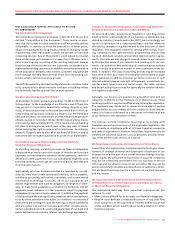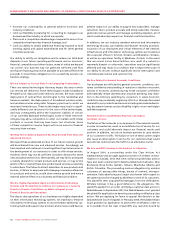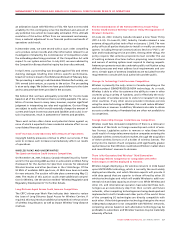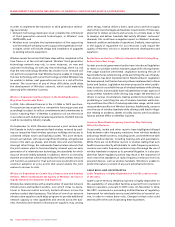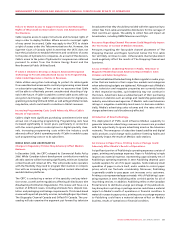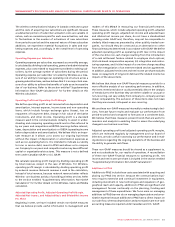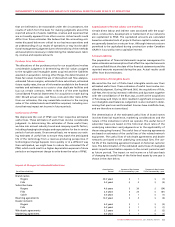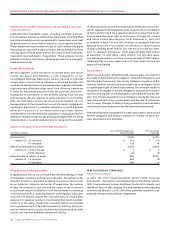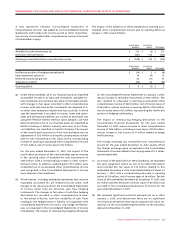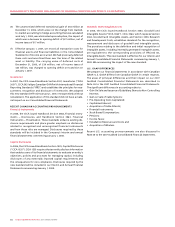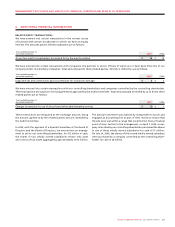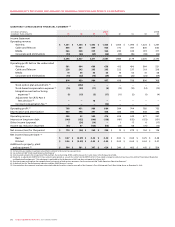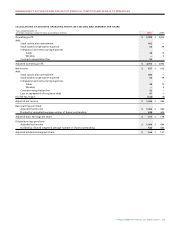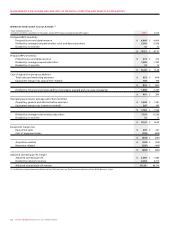Rogers 2007 Annual Report Download - page 68
Download and view the complete annual report
Please find page 68 of the 2007 Rogers annual report below. You can navigate through the pages in the report by either clicking on the pages listed below, or by using the keyword search tool below to find specific information within the annual report.
64 ROGERS COMMUNICATIONS INC. 2007 ANNUAL REPORT
MANAGEMENT’S DISCUSSION AND ANALYSIS OF FINANCIAL CONDITION AND RESULTS OF OPERATIONS
Impairment of Goodwill, Indefinite-Lived Intangible Assets and
Long-Lived Assets
Indefinite-lived intangible assets, including goodwill and spec-
trum/broadcast licences, as well as long-lived assets, including PP&E
and other intangible assets, are assessed for impairment on at least
an annual basis or more often if events or circumstances warrant.
These impairment tests involve the use of both undiscounted and
discounted net cash flow analyses to assess the recoverability of the
carrying value of these assets and the fair value of both indefinite-
lived and long-lived assets, if applicable. These analyses involve
estimates of future cash flows, estimated periods of use and appli-
cable discount rates.
Income Tax Estimates
We use judgment in the estimation of income taxes and future
income tax assets and liabilities. In the preparation of our
Consolidated Financial Statements, we are required to estimate
income taxes in each of the jurisdictions in which we operate. This
involves estimating actual current tax exposure, together with asses-
sing temporary differences that result from differing treatments
in items for accounting purposes versus tax purposes, and in esti-
mating the recoverability of the benefits arising from tax loss
carryforwards. We are required to assess whether it is more likely
than not that future income tax assets will be realized prior to
the expiration of the related tax loss carryforwards. Judgment is
required to determine if a valuation allowance is needed against
either all or a portion of our future income tax assets. Various
considerations are reflected in this judgment, including future prof-
itability of related companies, tax planning strategies that are being
implemented or could be implemented to recognize the benefits
of these tax assets, as well as the expiration of the tax loss carryfor-
wards. Judgments and estimates made to assess the tax treatment
of items and the need for a valuation allowance impact the future
income tax balances as well as net income through the current
and future income tax provisions. As at December 31, 2007, and
as detailed in Note 7 to the 2007 Audited Consolidated Financial
Statements we have non-capital income tax loss carryforwards
of approximately $2,001 million. Our net future income tax asset,
prior to valuation allowances, totals approximately $609 million
at December 31, 2007 (2006 – $836 million). The recorded valua-
tion allowance results in a future income tax asset of $490 million,
reflecting that it is more likely than not that certain income tax
assets will be realized.
Pension Plans
When accounting for defined benefit pension plans, assumptions
are made in determining the valuation of benefit obligations and
the future performance of plan assets. Delayed recognition of dif-
ferences between actual results and expected or estimated results
is a guiding principle of pension accounting. This principle results in
recognition of changes in benefit obligations and plan performance
over the working lives of the employees receiving benefits under the
plan. The primary assumptions and estimates include the discount
rate, the expected return on plan assets and the rate of compensa-
tion increase. Changes to these primary assumptions and estimates
would impact pension expense and the deferred pension asset.
The following table illustrates the increase (decrease) in the accrued
benefit obligation and pension expense for changes in these pri-
mary assumptions and estimates:
Impact of Changes in Pension-Related Assumptions
Accrued Benefit Obligation at Pension Expense
(In millions of dollars) End of Fiscal 2007 Fiscal 2007
Discount rate 5.25% 5.25%
Impact of: 1% increase $ (111) $ (11)
1% decrease 126 19
Rate of compensation increase 3.50% 3.50%
Impact of: 0.25% increase $ 5 $ 2
0.25% decrease (5) (2)
Expected rate of return on assets N/A 6.75%
Impact of: 1% increase N/A (6)
1% decrease N/A 6
Allowance for Doubtful Accounts
A significant portion of our revenue is earned from selling on credit
to individual consumers and business customers. The allowance for
doubtful accounts is calculated by taking into account factors such
as our historical collection and write-off experience, the number
of days the customer is past due and the status of the customer’s
account with respect to whether or not the customer is continuing
to receive service. As a result, fluctuations in the aging of subscriber
accounts will directly impact the reported amount of bad debt
expense. For example, events or circumstances that result in a dete-
rioration in the aging of subscriber accounts will in turn increase
the reported amount of bad debt expense. Conversely, as circum-
stances improve and customer accounts are adjusted and brought
current, the reported bad debt expense will decline.
NEW ACCOUNTING STANDARDS
Financial Instruments
In 2005, the CICA issued Handbook Section 3855, Financial
Instruments – Recognition and Measurement, Handbook Section
1530, Comprehensive Income, Handbook Section 3251, Equity, and
Handbook Section 3865, Hedges. The new standards were adopted
commencing January 1, 2007, and were generally required to be
adopted retrospectively without restatement.



